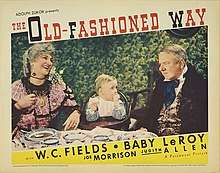Baby LeRoy
Baby LeRoy (May 12, 1932 – July 28, 2001) was a child actor who appeared in films in the 1930s. When he was sixteen months old, he became the youngest person ever put under term contract by a major studio.[1]
Baby LeRoy | |
|---|---|
 Lobby card for The Old Fashioned Way (1934) | |
| Born | Ronald Le Roy Overacker May 12, 1932 Los Angeles, California, U.S. |
| Died | July 28, 2001 (aged 69) Van Nuys, California, U.S. |
| Occupation | Baby |
| Years active | 1933–1935 |
Born Ronald Le Roy Overacker in Los Angeles, California, Baby LeRoy's career began when he was less than a year old, co-starring with Maurice Chevalier in A Bedtime Story, and ended with a cameo role as himself in Cinema Circus (1937). He is best known for his appearances in three W. C. Fields films: Tillie and Gus (1933), The Old Fashioned Way (1934) and It's a Gift (1934).
Screen interaction with W. C. Fields
.jpg)
Fields recounted a difficult shooting day during Tillie and Gus where a short scene was repeatedly ruined by Baby LeRoy's crying until he surreptitiously devised a solution: "I quietly removed the nipple from Baby LeRoy's bottle, dropped in a couple of noggins of gin, and returned it to Baby LeRoy. After sucking on the pacifier for a few minutes, he staggered through the scene like a Barrymore."[2]
LeRoy is perhaps best remembered for a dinner table sequence in the W. C. Fields comedy The Old Fashioned Way (1934) in which he throws a handful of custard into the comedian's face, yanks on his nose, and destroys his pocket watch by tossing it into a bowl of molasses. Fields initially endures each of these indignities, but the scene ends with Fields spotting Baby LeRoy standing in a doorway and giving the toddler a kick to the rear end. The film's director, William Beaudine, reported that the kick got "the biggest laugh in the picture."[3]
By the time of It's a Gift, Fields had wearied of the youngster, who was now getting second billing in the credits. "Fields had a phobia about the baby," said director Norman McLeod. "He not only hated infants in general, but he believed that Baby LeRoy was stealing scenes from him... He used to swear at the baby so much in front of the camera that I sometimes had to cut off the ends of the scenes in which they appeared."[4] Whether or not this animosity was legitimate, it greatly contributed to the popular impression of Fields, as famously summed up by Leo Rosten at a 1939 testimonial event: "The only thing I can say about Mr. W. C. Fields, whom I have admired since the day he advanced upon Baby LeRoy with an icepick, is this: Any man who hates dogs and babies can't be all bad."[5]
End of career
A starring role in the 1940 film The Biscuit Eater was to have been LeRoy's comeback. But while filming the first scene on location, which called for LeRoy to swing across a lake on a rope, he fell into the water twice.
By the following day, he had lost his voice from a cold. As the entire crew was on location, the accident forced the director to choose between recasting or holding up production until he recovered. The director chose to recast, and the film became one of Billy Lee's best-remembered roles. LeRoy never appeared in another film.[6]
Overacker became a merchant seaman[7] and in 1957, as an adult, appeared as a guest challenger on the TV panel show To Tell the Truth. He died in Van Nuys, California, in 2001, aged 69.
Filmography
| Year | Title | Role | Notes |
|---|---|---|---|
| 1933 | A Bedtime Story | Monsieur 'Baby' | |
| 1933 | Torch Singer | Bobby - Dora's Baby Year 1 | |
| 1933 | Tillie and Gus | The 'King' | |
| 1933 | Alice in Wonderland | Joker | |
| 1934 | Miss Fane's Baby Is Stolen | Michael Fane | |
| 1934 | The Old Fashioned Way | Albert Pepperday | |
| 1934 | The Lemon Drop Kid | Wally Jr. | |
| 1934 | It's a Gift | Baby Dunk | |
| 1935 | It's a Great Life | Buddy | |
| 1935 | Babes in Hollywood | LeRoy | Short, (final film role) |
Sources
- Curtis, James (2003), W. C. Fields: A Biography, Alfred A. Knopf Publishing.
- Holmstrom, John (1996). The Moving Picture Boy: An International Encyclopaedia from 1895 to 1995, Norwich, Michael Russell, p. 179.
- Dye, David (1988). Child and Youth Actors: Filmography of Their Entire Careers, 1914–1985. Jefferson, NC: McFarland & Co., p. 8.
- Lamparski, R. (1974), Whatever Became Of ...: The New Fifth Series, Bantam Books: New York.
- Best, Marc (1971). Those Endearing Young Charms: Child Performers of the Screen, South Brunswick and New York: Barnes & Co., pp. 161–165.
- Zierold, Norman J. (1965). The Child Stars. New York: Coward-McCann.
- Willson, Dixie (1935). Little Hollywood Stars. Akron, OH, and New York: Saalfield Pub. Co.
References
- Curtis, James, W. C. Fields: A Biography, Alfred A. Knopf Publishing, 2003, p. 272
- Curtis, p. 273
- Curtis, pp. 287–288
- Curtis, p. 306
- Curtis, p. 392
- "clothing and costumes worn by child actors: Baby LeRoy". Histclo.com. Retrieved 2011-12-27.
- Lamparski, p. 214
External links
- Baby LeRoy on IMDb